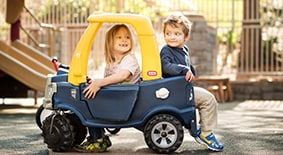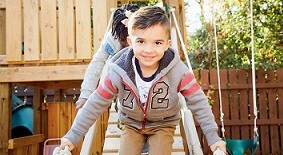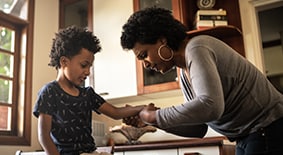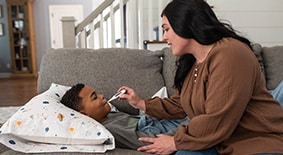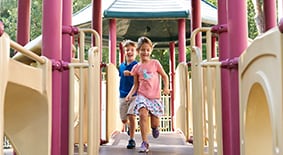How to Protect Kids from Common Bone Injuries
Accidents happen. Slips, falls, bumps and bruises aren’t uncommon when kids are playing outdoors or on the playground. But some playtime activities can put your child at risk for more serious injury. The bone injuries our pediatric orthopedic surgeons often see from common playtime activities may surprise you.
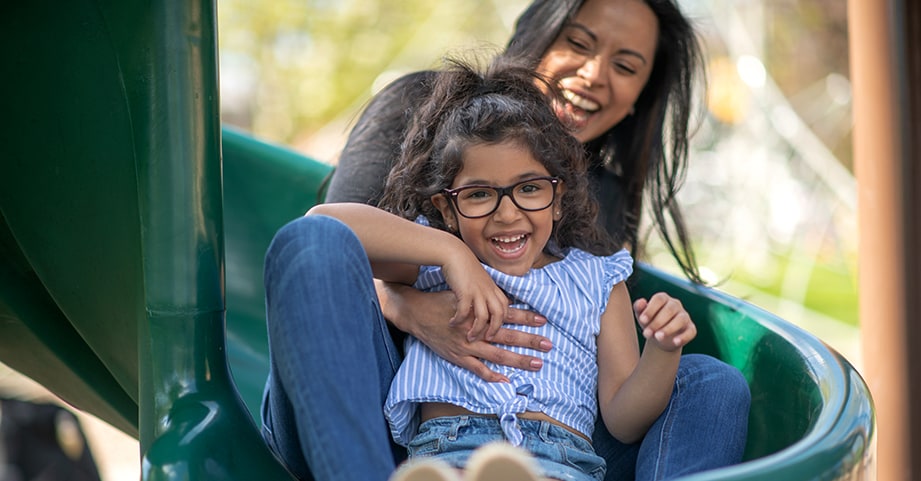
1. Little legs can get hurt when sliding with adults
Of all the equipment on the playground, slides are one of the most common spots for injuries to happen. There is the occasional daredevil who jumps from the top of the slide. But more often, it’s little ones who get hurt sliding down on a parent’s lap.
“A lot of younger toddlers may be afraid to go down the slide, or their parent thinks it's more fun if the child goes down the slide on their lap,” says Children's pediatric orthopedic surgeon Jill Flanagan, MD. “But often, kids will put their leg out to the side, and then the leg gets stuck. The twisting then breaks their leg. We see this type of tibia fracture a lot.”
The takeaway: If you want to slide with your child on your lap, pull their legs in and hold them on top of yours until you reach the bottom.
2. Falls from monkey bars can cause broken bones
The monkey bars are another place kids often get hurt. Swinging by your hands takes strength and skill some kids may not have fully developed. Your safest bet is to stay close by and spot your child as he or she goes from bar to bar. A slip and fall from a good height can cause a broken bone. And, according to Dr. Flanagan, elbows are often where these fractures occur.
“Kids don’t typically fall on their elbow when they slip off the monkey bars,” she says. “They fall on their outstretched hand, so the break occurs in a part of the arm bone called the humerus. This is just above the elbow joint, where the thinness of the bone makes it prone to cracking when the elbow is bent backward. Some of these fractures can be quite significant, and we have to do surgery to fix a lot of them."
3. Jumping from swings can lead to broken wrists
One run-in with a swing in motion is usually enough to teach kids not to wander too close. But a reminder now and then can’t hurt, especially if kids seem distracted from what’s going on around them.
As kids get older and more adventurous, swings may be an even greater risk because of the temptation to jump off. “This trick often leads to two broken wrists and casts on each arm,” says Dr. Flanagan.
4. Swinging kids by their arms can cause nursemaid’s elbow
You don't want to pull your child up or swing them by their hands. This puts stress on their elbows and can cause a condition called nursemaid’s elbow, explains Dr. Flanagan. “This is a common injury in early childhood that happens when a child’s elbow is pulled and partially dislocated. Unfortunately, if it happens once, there’s a good chance it will happen again.”
5. Bouncing can have its ups and downs
Some parents opt to give kids a designated place to jump around, like a trampoline or bounce house. If you decide to go that route, then here are some safety guidelines to consider:
- Limit the number of bouncers. A trampoline or bounce house that is too crowded increases the risk of kids bumping heads or jumping on top of one another. As a general rule, limit trampolines to one jumper and follow recommended guidelines for what number is suitable for each bounce house.
- Avoid mixing age groups. It may be common sense, but putting a toddler in a bounce house with teens is a recipe for disaster. There’s just too much of a size difference. Not only will the little one get over-bounced but they may get stepped on as well. This rule applies to parents, too. No matter how careful you try to be, bouncing with your child puts them at risk.
- Prohibit flips. There’s always that temptation to try new tricks on the trampoline. But the fact is, flips and somersaults are dangerous, especially when kids are inexperienced. All it takes is one bad landing to cause a serious injury to the head or neck.
- Keep doors and nets closed. The only trampoline your child should be using is one fully enclosed in a net. Make sure the opening is closed tightly while they’re jumping. This goes for bounce houses, too.
Parent tip: Keep your eyes on the kids
Just because kids are entertained doesn’t mean parents are off duty. We all get tempted to take a break while our kids are busy playing. The problem: If you’re on your phone texting with friends or engaged in a conversation with another parent, then you’re probably not keeping a close watch on your kids.
“It’s important for parents to understand that a lot of injuries we see are preventable,” says Dr. Flanagan. “Kids can get hurt by fluke accidents, of course, but then other injuries are caused by poor decisions. Parents can't avoid the fluke accidents, but the poor decisions we can often control just by watching our kids."
At the end of the day, there’s only so much we can do to protect our kids. Accidents can and will happen. Knowing how to respond will help ensure that your child gets the care they need when they need it.
What to do if you think your child broke a bone
If your child is calm, but is experiencing swelling or bruising and isn’t moving the affected limb, then reach out to your pediatrician or our orthopedic team to arrange an appointment.
A crooked limb is an obvious sign that a break has occurred. In this case, get to a pediatric urgent care facility as soon as possible.
If you can see bone protruding through the skin, quickly make your way to the emergency room.
Weekend Clinic for Injuries
Sprains, strains and broken bones don’t wait for weekdays. If your child needs to see a pediatric orthopedic expert on a weekend, Children’s has appointments available on Saturdays in Sandy Springs and Sundays in Duluth. Make an appointment online or call 404-255-1933 to schedule.
Make an AppointmentJill C. Flanagan, MD, is a Pediatric Orthopedic Surgeon at Children’s Healthcare of Atlanta. She is trained in advanced techniques and technologies, such as using the Taylor Spatial Frame, TL-Hex frame and Precice nail. Her expertise in limb lengthening has led to invitations from the Baltimore Limb Deformity Course to teach others how to perform limb-lengthening surgeries for complex disorders of the hip, knee, shoulder and elbow as well as all sports-related injuries.
This content is general information and is not specific medical advice. Always consult with a doctor or healthcare provider if you have any questions or concerns about the health of a child. In case of an urgent concern or emergency, call 911 or go to the nearest emergency department right away. Some physicians and affiliated healthcare professionals on the Children’s Healthcare of Atlanta team are independent providers and are not our employees.
Contact Us 404-255-1933
